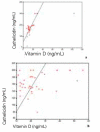The Association between Serum 25-Hydroxy Vitamin D Level and Urine Cathelicidin in Children with a Urinary Tract Infection
- PMID: 27180947
- PMCID: PMC5096497
- DOI: 10.4274/jcrpe.2563
The Association between Serum 25-Hydroxy Vitamin D Level and Urine Cathelicidin in Children with a Urinary Tract Infection
Abstract
Objective: Cathelicidin is an important antimicrobial peptide in the urinary tract. Cathelicidin expression is strongly stimulated by 1,25-dihydroxy vitamin D in epithelial cells, macrophages/monocytes, and neutrophils. Vitamin D and cathelicidin status in children with urinary tract infection (UTI) caused by Escherichia coli is unknown. To establish the relationship between serum vitamin D and urine cathelicidin levels in children with a UTI caused by Escherichia coli.
Methods: Serum 25-hydroxy vitamin D and urine cathelicidin levels were measured in 36 patients with UTI (mean age 6.8±3.6 years, range: 0.25-12.6 years) and 38 controls (mean age 6.3±2.8 years, range: 0.42-13 years).
Results: There were no significant differences in urine cathelicidin levels between the study and control groups (p>0.05). Eight (22.2%) patients in the study group and 21 (58.3%) children in the control group were found to have sufficient vitamin D (≥20 ng/mL). Patients with sufficient vitamin D had higher urine cathelicidin levels than the controls with sufficient vitamin D (respectively 262.5±41.1 vs. 168±31.6 ng/mL, p=0.001). There were no significant differences between the patients and controls with insufficient vitamin D (p>0.05).
Conclusion: The children with vitamin D insufficiency may not be able to increase their urine cathelicidin level during UTI caused by Escherichia coli. There is a need of prospective studies in order to prove a beneficial effect of vitamin D supplementation for the restoration of cathelicidin stimulation and consequently for prevention of UTI recurrence.
Figures

References
-
- Craig JC. Urinary tract infection: new prospectives on a common disease. Curr Opin Infect Dis. 2001;14:309–313. - PubMed
-
- Brandström P, Hansson S. Long-term, low-dose prophylaxis against urinary tract infections in young children. Pediatr Nephrol. 2015;30:425–432. - PubMed
-
- Holick MF, Chen TC. Vitamin D deficiency: a worldwide problem with health consequences. Am J Clin Nutr. 2008;87:1080–1086. - PubMed
-
- Borella E, Nesher G, Israeli E, Shoenfeld Y. Vitamin D: a new anti-infective agent? Ann N Y Acad Sci. 2014;1317:76–83. - PubMed
MeSH terms
Substances
LinkOut - more resources
Full Text Sources
Other Literature Sources
Medical
